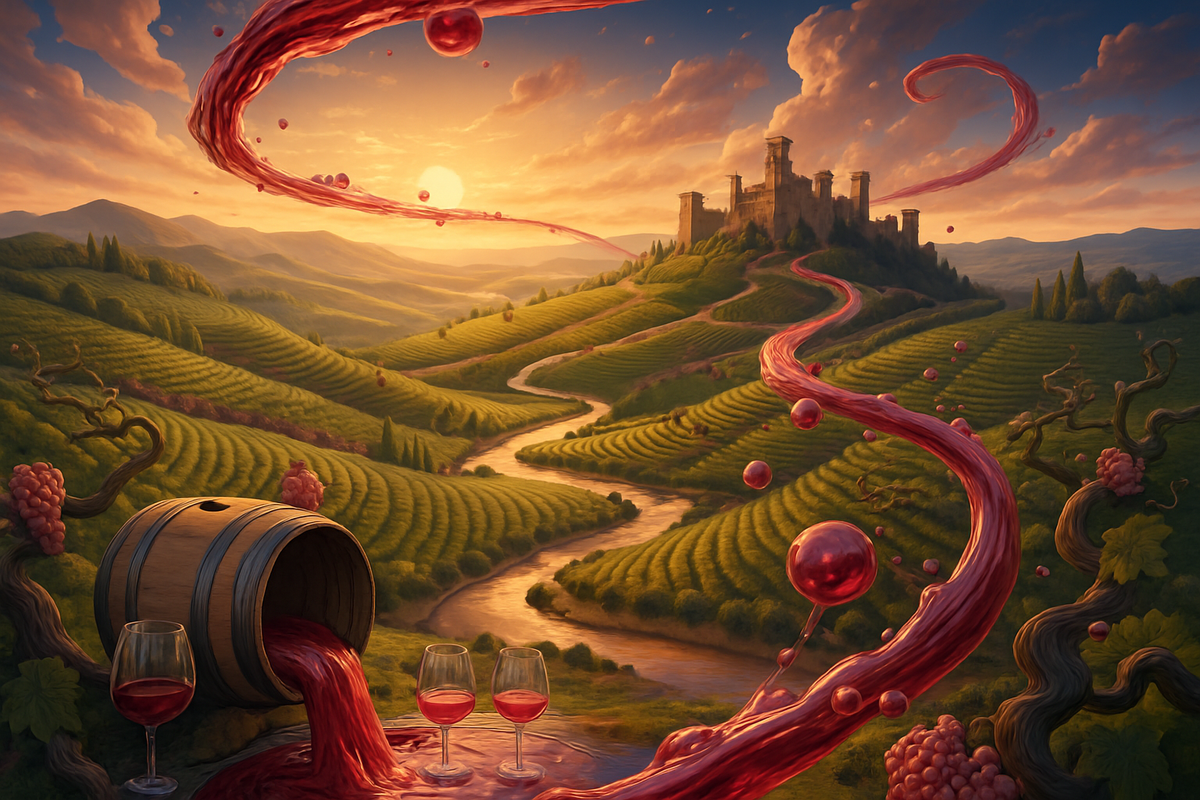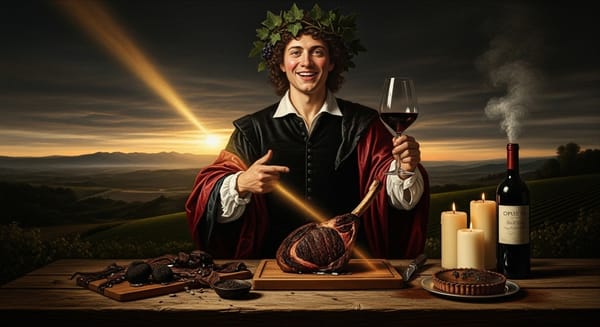Barolo DOCG: Time, Tannin & the Long Road to Grace
Uncover Barolo’s evolution—from Savoy courts to eco-minded cellars—and how Nebbiolo translates Langhe’s varied soils into wines of tensile elegance and depth.

Where Dawn Drips From Vines
The Langhe wakes in layers of memory. Dawn’s fog coils around stone farmhouses whose foundations pre‑date the House of Savoy, murmuring stories as it drifts up the vine rows. Each Nebbiolo cluster seems to archive centuries—papal decrees, soldiers’ march‑songs, monks pressing grapes in vats older than the nation itself. Here, time is no straight road but a spiral: every vintage revisits what came before, then bends ever so slightly toward the unknown.
Stand on a ridge above Serralunga and you feel the pulse of ages: Roman amphora shards slumber beneath the soil, medieval watchtowers carve dark shapes against a paling sky, and charcoal initials scrawled by sharecroppers in 1880 still fleck cantina beams. The landscape has never truly paused; it only trades instruments, from ox‑drawn plough to sharpened steel, from calloused hands to laser‑guided pruning shears. Yet the melody persists—a dialogue between fragile skins and ironclad tannin, between autumn’s cooling hush and the ember‑bright decades sealed beneath a cork.
To taste Barolo is to intercept continuity. One sip grafts you onto a conversation that started long before your arrival and will continue long after the glass empties. That humility—knowing you are but a fleeting guest in an epic of harvests—sets the rhythm for everything that follows.
Chronicles Etched in Grapevine Ink: An Unfolding of Power and Persuasion
Monarchy & Risorgimento
Barolo’s modern narrative opens in the 19th century, when the House of Savoy treated wine as geopolitical soft power. Count Camillo Benso di Cavour, more statesman than farmer, hired French oenologist Louis Oudart to civilise Nebbiolo’s ferocity in the castle of Grinzane. Stainless steel was a century away, yet temperature‑controlled cellars—achieved by partially burying fermenting vats in water—allowed longer macerations without runaway volatility. Meanwhile, Marchesa Giulia Colbert Faletti, the original brand strategist, dispatched polished bottles to royal banquets across Europe. When Piedmont’s troops marched south bearing the dream of a unified Italy, they brought casks of Barolo as liquid propaganda: taste what a future kingdom could savour.
From Post‑Unità to Pre‑War Adaptive Hustle
Italy’s unification in 1861 did little to shield farmers from the triple storm of phylloxera, share‑cropping, and erratic export tariffs. Between 1890 and 1930, vineyard land fell by nearly a third, replaced by wheat and hazelnuts better suited to fluctuating markets. Yet crisis bred ingenuity. Grafted American rootstocks saved Nebbiolo from extinction, while local co‑operatives pooled resources for mechanical presses and bottling lines. Agricultural institutes in Alba experimented with clonal selections—Michet, Lampia, Rosé—documenting which buds set best on high versus low expositions. By 1934 the first legally defined Barolo production zone was penned, anchoring identity in legislation rather than folklore.
War, Reconstruction & the Hinterland Renaissance
World War II shelled railways and fragmented landholdings. Stories circulate of families hiding demijohns behind false walls to protect them from both fascists and partisans. The 1950s rebuilding era saw migrant labourers return home, installing electricity in farmhouses and, crucially, refrigeration in cellars. Malolactic fermentation—once a chaotic springtime surprise—could now be induced or suppressed with intent. Rural schools taught chemistry; daughters as well as sons attended oenology courses, planting the seed for today’s cadre of female winemakers who run family domains with unapologetic authority.
The Barolo Boys & the 1990s Voltage Spike
Fast‑forward to the late 20th century: cellars buzzed with roto‑fermenters, staves of Tronçais oak, and a generation eager to make Nebbiolo converse in multiple dialects. Elio Altare chainsawed old botti in an act half symbolic, half pragmatic; Luciano Sandrone courted fruit purity with laser‑precise temperature control; Enrico Scavino shortened macerations to spotlight perfume over grip. Traditionalists counter‑punched with 60‑day submerged‑cap ferments and botti the size of commuter buses. The clash electrified critics, luring global palates back to a region many had relegated to dusty cellars and daunting tannins.
Two decades later, the feud resembles sibling banter rather than civil war. Former iconoclasts now deploy large casks for tertiary élevage; staunch classicists sometimes finish a cuvée in second‑use barriques. The real victor is consumer choice—an amphitheatre where multiple stylistic voices echo without canceling each other.
The Valleys' Shifting Geometry: Five Hills, Infinite Edges
Trying to compress eleven communes into one tasting note is like describing jazz as "sound." Each slope offers its own rhythm section of soil, altitude, and orientation.
La Morra & Barolo (Commune)
Tortonian marls dominate, a limestone‑rich matrix leavened by magnesium and nickel that lifts aromatics into red‑fruit territory—think raspberry coulis laced with anise. Clay pockets hold water, softening tannin trajectories so wines feel almost Burgundian in glide, though never in fragility.
Castiglione Falletto
Here the earth is a dialectical argument between Tortonian and Helvetian epochs: sandstone layers stack atop compact limestone, granting both aromatic delicacy and tactile grit. Wines smell of rose petal stitched to rusted iron and taste like pomegranate seeds dusted over warm brick.
Monforte d’Alba
Altitude climbs to 500 m, nights fall hard, and diurnal swings preserve acidity that snaps like a snare drum. Helvetian sandstone turns tannins into scaffolding rather than sandpaper; violet and graphite typically headline the aromatic playbill.
Serralunga d’Alba
Iron‑laden soils act like a tuning fork, amplifying Nebbiolo’s bass notes: tar, black licorice, dried porcini. Structure can feel architectural—domes and buttresses of tannin that require a decade’s seasoning before they welcome visitors.
Outlying Voices—Verduno, Novello, Roddi
Verduno’s chalky tongues birth Monvigliero, a cru whose saffron‑spiked aromatics defy the idea that power requires darkness. Novello’s Ravera harnesses high limestone to stretch flavours along a laser pointer of acidity. Roddi, once an afterthought, is gaining currency as climate change bathes its cooler folds in just enough summer heat.
Climate in a Warming World
The data show harvest dates advancing roughly ten days compared with the 1980s. Yet peak summer sees midday temps above 32 °C only sporadically, and nights often dive below 15 °C thanks to cold drains from the Alps. Growers combat new extremes with dynamic canopy management—leaving extra leaves on the western side to ward off afternoon scorch, but pulling them early on the eastern flank to dry dew and stave off mildew. Many estates are testing drought‑resistant rootstocks like 1103‑P to pair with higher parcellations above 450 m, essentially building vertical insurance policies against unseasonable heat.
The 2021 vintage demonstrates this adaptive choreography: a snowy winter replenished groundwater, a warm yet not torrid summer followed, and September’s cool nights locked acidity into fruit that critics already compare to benchmark years 2010 and 2016. Early barrel samples hum with tension rather than bulk, suggesting longevity wrapped in immediacy.
Hands in Concert With Earth
Nebbiolo behaves like an over‑eager marathoner: early to bud, late to finish, and brutally transparent about its training regimen. Elevating quality means disciplining that energy without muzzling it. DOCG law caps yields at 38 hL/ha, but top estates routinely target 28–32. Green harvests occur as early as late June, when bunches are still pea‑sized, so remaining fruit ripens in unified cadence.
Cover crops have evolved from cosmetic wildflowers to data‑driven prescriptions: barley under vigorous rows to compete for water, crimson clover where nitrogen needs a bump, and white mustard to bio‑fumigate nematodes between vine trunks. Aerial drones equipped with multispectral cameras map chlorophyll density, enabling precision irrigation on plots where clay lenses trap moisture and reduce vine stress.
Pest management now leans on mating‑disruption pheromone ties rather than broad‑spectrum insecticides. One hectare may host 500 ties that confuse Lobesia botrana moths into sterile loops, dropping worm‑damaged clusters below 2 %. The result: healthier skins, cleaner ferments, and reduced sulfur needs during winemaking.
Nebbiolo’s Fierce Grace Unfurled
Out of context, raw Nebbiolo can seem obstinate: thin skins yet muscular tannins, high acids that overshadow fruit, colors closer to mahogany than opaque ruby. But Barolo’s alchemy transmutes those seeming weaknesses into multi‑dimensional strength.
Primary Palette (0–5 years)
Expect sour cherry, blood orange, and rosehips crackling with white pepper. Tannins prickle like static after dragging wool across carpet, and acidity drives flavours toward the nasal cavity even after swallowing.
Secondary Symphony (6–15 years)
Fruit recedes but doesn’t vanish. Layers of porcini stock, fennel pollen, and sweet tobacco arise, interlacing with camphor and a hint of iodine that recalls sea breeze trapped in mountain stone. Mouthfeel widens; tannins transition from angular to architectural, as if hand‑planed.
Tertiary Tapestry (>15 years)
Leather softens to suede, tart fruit becomes preserved plum, and an echo of truffle competes with chimney smoke on a wet November night. The color drifts toward transparent garnet but lights up like stained glass when held to flame. Texture shifts yet again—liquid dissolves into something approaching silk infused with iron filings.
Importantly, modern, fruit‑forward styles do not shortcut this evolution; they merely alter the opening chords. Whether a wine began life in small French oak or cavernous botti, genetic code exerts final authority once tertiary notes call roll.
Cellar Wars & Quiet Transformations
Traditionalists liken fermentation to a pilgrimage: cap submerged 40–60 days, temperature nudged only by weather, spontaneous yeasts exploring terrain as monks explore scripture. The resulting tannin matrix can appear forbidding but grants wine the spine for half‑century cellaring.
Modernists treat fermentation like surgical theatre. Roto‑fermenters rotate must, extracting color and aroma in rapid micro‑steeps under inert gas. Temperatures sit at 28 °C, not 35. Maceration ends in seven days, and free‑run juice slips into 225‑litre barriques where micro‑oxygenation rounds edges without diluting identity. Critics once decried vanilla notes as foreign accents; today's artisans employ second‑ or third‑fill barrels to let wood whisper rather than shout.
Hybrid philosophies flourish. Giulia Negri ferments half her Serradenari fruit in open‑top wood before finishing in fifth‑passage barriques. Fabio Alessandria deploys concrete for primary, botti grande for élevage, then a month of bottle rest under low‑pressure argon to knit aromatics. Each tweak accelerates or decelerates facets of phenolic polymerisation; the goal is equilibrium, not dogma.
Echoes of Craft Along the Ridge
Verduno
Fratelli Alessandria frames Monvigliero like a saffron‑laced silk scarf flapping in Alpine wind—perfume first, structure trailing in stealth. At GB Burlotto, Fabio Alessandria resurrects foot treading and 60‑day macerations, proving perfume need not perish under tradition’s weight.
La Morra
Roberto Voerzio famously prunes to four bunches per vine, sculpting fruit that shines like back‑lit stained glass. Cordero di Montezemolo loops biodynamic horn manure into their regimen, citing sap analysis that shows smoother potassium uptake and more resilient skins.
Barolo (Commune)
Bartolo Mascarello remains a bastion of pre‑blended ethos; Maria Teresa Mascarello assembles wine from different crus before fermentation, arguing that harmony starts at crush, not in botti. G.D. Vajra toys with amphorae for certain parcels of Bricco delle Viole, chasing a dialogue between clay micro‑porosity and Nebbiolo’s volatile phenols.
Monforte d’Alba
Poderi Aldo Conterno deploys rotary fermenters only for initial extraction, then finishes in 2,800‑litre botti, producing Bussia that tastes like bass strings plucked under cathedral arches. Elio Grasso retreated from heavy barrique use in the 2000s, now favouring 40‑hectolitre casks to let their Ginestra site speak in surround sound.
Serralunga d’Alba
Cappellano refuses critic scores, selling wine to those who visit the estate or trust the story. Their Pie Franco bottling, ungrafted and rooted in sand pockets immune to phylloxera, offers tannins that feel less like scaffolding and more like the grip of polished basalt. Massolino experiments with cement eggs for Vigna Rionda fermentation, reporting heightened mid‑palate tension.
Each producer bends Nebbiolo’s arc toward individual expression, yet a through‑line of tension and lift persists, reminding drinkers that Barolo is united more by energy than by script.
Time’s Embrace & The Uncorking Hour
Barolo reaches the market with its chassis exposed but its engine purring. The 2019s will likely peak around 2032–2040; the solar‑charged but balanced 2017s are entering a plateau where tannins go satin yet fruit remains vivid. Revisit 2013s now for a dial‑tone between tart cherry and truffle, while venerable 2001s hum on overtones of balsamic reduction and Cuban cigar.
Cellars should hover around 13 °C with 70 % humidity. Data‑loggers that ping smartphones when temps creep above 15 °C are standard kit among serious collectors. For service, young bottles demand a wide‑base decanter and two hours to integrate volatile acidity; veterans prefer slow‑ox and gentle double‑decanting to avoid stripping tertiary nuance.
Pairings need not wallow in tradition alone. Yes, brasato al Barolo remains transcendent, but try miso‑marinated eggplant, Korean galbi, or even Nigerian egusi stew—the wine’s acidity lifts fat while tannins negotiate spice into bass‑line warmth.
Promises Penned in Ruby Ink
True value in Barolo lies in orchestrating a rendezvous with your future self. A purchased bottle becomes a promissory note payable in sensory currency.
Beyond that, every bottle is a question addressed to time: when will its story intersect with yours? Some rest like sealed letters, their ink still wet beneath the cork; others hum with impatience, vibrating against the dark like distant cicadas. A cellar is less a vault than a diary yet to be written, its margins filling slowly with the fingerprints of days not yet lived.
Profit and loss are mortal currencies; Barolo traffics in something subtler. Interest accrues as anticipation, dividends pay out in the hush before a cork lifts, and capital gains manifest as a scent so vivid it drags a forgotten decade into the room. Those who hoard bottles without opening them do not become wealthy—they merely postpone astonishment.
So lay wines down not to accumulate but to connect: to future selves, to absent friends, to evenings that will need an extra hour because the conversation refuses to land. The value of Barolo is never locked inside glass; it is released the moment you decide that now—exactly now—is worth remembering.
Lightning Bottled in Amber
Barolo is no monument frozen in time; it is a lightning bolt filmed in slow motion yet felt as flash. Its energy arcs across centuries, fermentations, and personal milestones, urging drinkers to accelerate imagination. Leave half the bottle for tomorrow—not to watch it rest, but to observe how it recalibrates overnight, scattering new sparks the moment oxygen rewires its circuitry. In these hills, energy is never lost—only converted, then handed to the next pair of curious hands.





